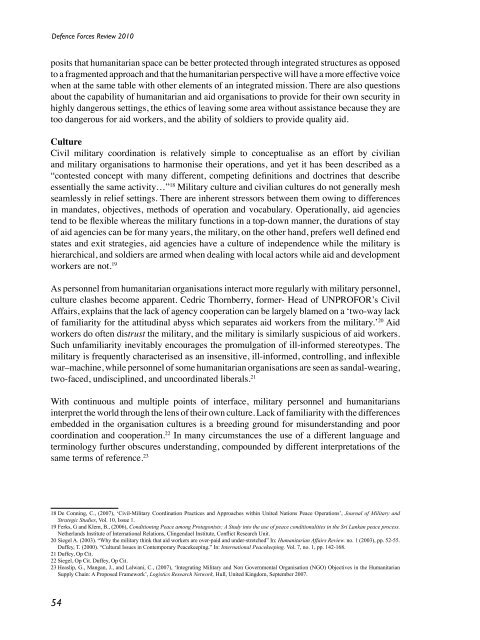Defence Forces Review 2010
Defence Forces Review 2010
Defence Forces Review 2010
You also want an ePaper? Increase the reach of your titles
YUMPU automatically turns print PDFs into web optimized ePapers that Google loves.
<strong>Defence</strong> <strong>Forces</strong> <strong>Review</strong> <strong>2010</strong>posits that humanitarian space can be better protected through integrated structures as opposedto a fragmented approach and that the humanitarian perspective will have a more effective voicewhen at the same table with other elements of an integrated mission. There are also questionsabout the capability of humanitarian and aid organisations to provide for their own security inhighly dangerous settings, the ethics of leaving some area without assistance because they aretoo dangerous for aid workers, and the ability of soldiers to provide quality aid.CultureCivil military coordination is relatively simple to conceptualise as an effort by civilianand military organisations to harmonise their operations, and yet it has been described as a“contested concept with many different, competing definitions and doctrines that describeessentially the same activity…” 18 Military culture and civilian cultures do not generally meshseamlessly in relief settings. There are inherent stressors between them owing to differencesin mandates, objectives, methods of operation and vocabulary. Operationally, aid agenciestend to be flexible whereas the military functions in a top-down manner, the durations of stayof aid agencies can be for many years, the military, on the other hand, prefers well defined endstates and exit strategies, aid agencies have a culture of independence while the military ishierarchical, and soldiers are armed when dealing with local actors while aid and developmentworkers are not. 19As personnel from humanitarian organisations interact more regularly with military personnel,culture clashes become apparent. Cedric Thornberry, former- Head of UNPROFOR’s CivilAffairs, explains that the lack of agency cooperation can be largely blamed on a ‘two-way lackof familiarity for the attitudinal abyss which separates aid workers from the military.’ 20 Aidworkers do often distrust the military, and the military is similarly suspicious of aid workers.Such unfamiliarity inevitably encourages the promulgation of ill-informed stereotypes. Themilitary is frequently characterised as an insensitive, ill-informed, controlling, and inflexiblewar–machine, while personnel of some humanitarian organisations are seen as sandal-wearing,two-faced, undisciplined, and uncoordinated liberals. 21With continuous and multiple points of interface, military personnel and humanitariansinterpret the world through the lens of their own culture. Lack of familiarity with the differencesembedded in the organisation cultures is a breeding ground for misunderstanding and poorcoordination and cooperation. 22 In many circumstances the use of a different language andterminology further obscures understanding, compounded by different interpretations of thesame terms of reference. 2318 De Conning, C., (2007), ‘Civil-Military Coordination Practices and Approaches within United Nations Peace Operations’, Journal of Military andStrategic Studies, Vol. 10, Issue 1.19 Ferks, G and Klem, B., (2006), Conditioning Peace among Protagonists: A Study into the use of peace conditionalities in the Sri Lankan peace process.Netherlands Institute of International Relations, Clingendael Institute, Conflict Research Unit.20 Siegel A. (2003). “Why the military think that aid workers are over-paid and under-stretched” In: Humanitarian Affairs <strong>Review</strong>. no. 1 (2003), pp. 52-55.Duffey, T. (2000). “Cultural Issues in Contemporary Peacekeeping.” In: International Peacekeeping. Vol. 7, no. 1, pp. 142-168.21 Duffey, Op Cit.22 Siegel, Op Cit. Duffey, Op Cit.23 Heaslip, G., Mangan, J., and Lalwani, C., (2007), ‘Integrating Military and Non Governmental Organisation (NGO) Objectives in the HumanitarianSupply Chain: A Proposed Framework’, Logistics Research Network, Hull, United Kingdom, September 2007.54
















